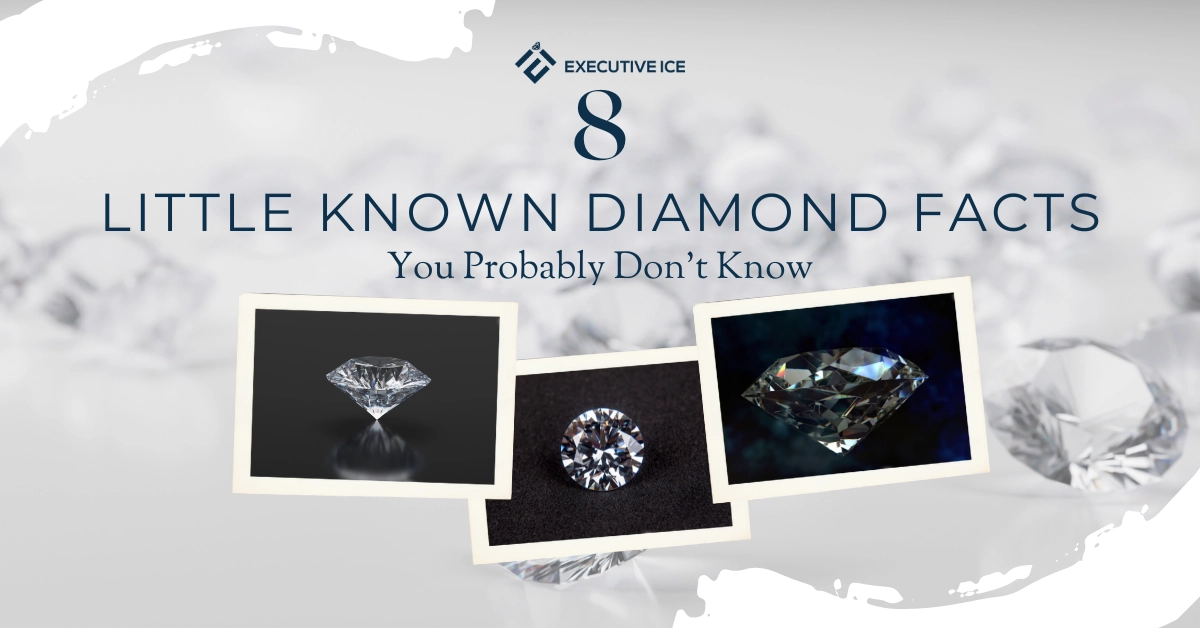Diamonds, they say, are a girl’s best friend. And that’s not a modern sentiment.
These dazzling gems have been charming us for centuries, hanging around the necks of kings and queens, or sparkling on their fingers.
Over time, diamonds have accrued their fair share of fascinating trivia, making them not just gorgeous, but intriguing as well.
Whether you want to impress your partner with your diamond knowledge or add an extra layer of significance to your own diamond engagement ring, these fun facts are sure to sparkle at your next social gathering.
And if you’re still on the hunt for the perfect diamond, make sure to equip yourself by learning how to buy diamonds like a pro and exploring our comprehensive guide to top diamond jewelry retailers.
1. How They Got Their Name
Did you know the term ‘diamond’ originates from the Greek word ‘adamas,’ signifying ‘untamed’ or ‘unbreakable’? This ancient word perfectly encapsulates the enduring and indestructible nature of these precious stones.
2. Where They Discovered
You might think diamonds were first discovered in Africa, but that’s not the case.
Surprisingly, the story of diamonds begins in India. The rivers and streams of this vibrant country were the original sources of these sought-after gems, which were initially collected and traded among India’s elite.
It wasn’t until the conquest of India by Alexander the Great in 327 BC that diamonds found their way to Europe. Alexander the Great, captivated by the radiant gems, transported them from India to Europe, sparking a fascination that has lasted for centuries.
This period also marked the beginnings of diamond trade routes from India to Europe, as diamonds were dispatched via caravans to feed the growing European appetite.
3. South Africa had its Very Own Diamond Rush
Did you know that South Africa is home to the world’s most abundant diamond reserves?
The discovery that sparked the famous South African diamond rush took place in 1867, all thanks to a group of children who stumbled upon a rock that was, in fact, a precious diamond.
This find led to a rush of mining activity, and many of the stones unearthed during this time were fashioned into the exquisite Victorian diamond jewelry that we admire today.
4. What Are They Made of
You might be surprised to learn that diamonds are composed of a simple element: carbon.
This fact was scientifically proven in 1772 by Antoine Lavoisier. By focusing sunlight on a diamond using a lens within an oxygen-rich environment, Lavoisier observed that the only product formed was carbon dioxide, thereby proving that diamonds are pure carbon.
5. Alternate Creation Theories
While science tells us one thing about the origins of diamonds, ancient Indian mythology offers a more dramatic explanation.
According to Hindu beliefs, diamonds were created when lightning bolts struck rocks. It was also believed that diamonds had the power to attract lightning and could thus shield the wearer from harm.
Even today, it’s often said that wearing a diamond can ward off danger, a belief that can be traced back to these ancient tales.
6. How Engagement Rings were Born
The tradition of using diamond rings for marriage proposals traces its roots back to 1477 when Archduke Maximilian of Austria proposed to Mary of Burgundy.
He presented her with a uniquely designed ring that was M-shaped and adorned with thin, flat pieces of diamond. This momentous event marked the start of the enduring association between diamond rings and proposals.
7. Diamonds Helped Building our First Cars
Diamonds have had a fascinating role in the history of the automotive industry.
Henry Ford, the famed founder of the Ford Motor Company, was the first to incorporate diamonds in car manufacturing.
He financed research to produce lower-grade diamonds that could be used as cutting tools, proving the versatile application of this precious gem.
8. Biggest Diamond Ever Found
Named after Sir Thomas Cullinan, the owner of the mine where it was discovered, the ‘Cullinan’ is the largest diamond ever found.
Weighing an incredible 1.37 pounds (or 3106 carats), it was unearthed by miner Frederick Wells 18 feet below ground in Pretoria, South Africa on January 25, 1905.
Today, the diamond is estimated to be worth a staggering $400 million.
Sir Thomas commissioned Joseph Asscher to cut the stone, which finally yielded a diamond of 971 carats. Asscher dedicated six months to studying the diamond before making the first cut, and after his initial attempts, he reportedly fainted from exhaustion.
Summary
These eight intriguing facts provide a fascinating glimpse into the world of diamonds. Armed with this information, you’ll have something extraordinary to discuss the next time diamonds become a topic of conversation.
Whether you’re planning a proposal or simply fascinated by these precious stones, there’s always more to discover about diamonds.




